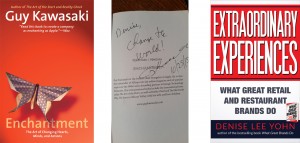Guy Kawasaki on Enchanting Brands
What do great brands do? Guy Kawasaki would suggest — and I would agree — that great brands are enchanting brands — they fill people with great delight. Great brands change people’s hearts, minds, and actions — including inspiring them to buy something, but it’s usually about more than that.
A few years ago, Guy wrote Enchantment: The Art of Changing Hearts, Minds, and Actions, a terrific book how to “bring about a voluntary, enduring, and delightful change in other people.” The other night when I had the chance to hear Guy speak (more on that some other time) and ask him to sign my copy of Enchantment, I was reminded of how much his book had influenced my thinking about brand-building. And I thought revisiting his advice would be the perfect way to kick off the launch of my new book, Extraordinary Experiences: What Great Retail and Restaurant Brands Do.
You see, Extraordinary Experiences shows you how to earn customer love and loyalty by creatively designing and consistently delivering great retail customer experiences — and it builds on the brand-building principles from my first book, What Great Brands Do, which include Great Brands Avoid Selling Products and Great Brands Don’t Chase Customers. It’s pretty clear that great customer experiences and great brands employ the advice in Guy’s Enchantment like these three points:
– Be likeable. It sounds so basic — of course, a brand should be likeable — but you need to be deliberate about it. Guy explains how to be likeable as a person, including attending to your smile, dress, handshake, and vocabulary. It’s small details like these that convey volumes about a person — and the same could be said about brands.
In Extraordinary Experiences I write about how PIRCH, a high-end appliance and plumbing retailer, sweats the small stuff in its customer experience. PIRCH showrooms are exquisitely designed and incorporate all sorts of details like fully-working shower heads and restrooms that showcase several PIRCH products. But the one thing that shows how committed the company is to its customers is a sign that reads, “In the effort to be fully transparent, we will make mistakes, but when we do, we will work very hard until we fix them completely, and we’re so confident of this, here’s our CEO’s phone number.” Designing and managing customer experience is a big undertaking that requires thinking small — giving small details a lot of attention, that is. With so many moving parts in a retail operation, it’s easy to overlook certain touchpoints or to think the small ones don’t matter if the big ones are on-brand. But it’s often the smallest of details that produce the most delight.
– Be trustworthy. Again a pretty basic point, but Guy explains that in order for others to trust you, you must trust others first. Brands that execute with consistency and communicate with transparency will get people to trust them — but great brands convey their respect for and trust in their customers first, whether by offering a liberal return policy, getting involved in causes their communities care about, or even not taking a price increase when everyone else is.
Jason’s Deli, a fast casual restaurant that I profile in Extraordinary Experiences, provides a terrific example. President Rob Tortorice told me, “We have heard ‘leave value on the plate’ from [Joe, our founder] for years . . . . We have chosen to eat commodity increases to the benefit of our guests. We source high quality foods and choose to offer bigger portions than our competitors at market or below market pricing because we feel that value proposition builds brand loyalty.”
He went on to admit that sticking to this approach hasn’t been easy, saying, “I do not need to tell you how difficult that has been over the last 10 years as the market is more volatile than ever. Over the years, yes, we have had to raise prices, especially the last few years with beef, but we will never reduce portions or lower quality expectations because that is not what our customers want and [doing that] does not meet our core values.” No wonder people have responded by rewarding Jason’s Deli with the second highest per-unit revenue in the quick-serve restaurant category.
– Tell a story. Guy hears a lot of pitches from entrepreneurs looking for investors and most of them follow the same, boring, fact-based presentation template. But, he writes in his book, “Enchanting launches…captivate people’s interest and imagination by telling a compelling story.” In the same way, great retailers and restaurateurs don’t just sell products, they design enchanting experiences that captivate people.
Take H-E-B, a Texas-based grocery store chain. Shopping at H-E-B is a fully immersive experience. The multitude of food samples available throughout its stores is outdone only by the generous wine sampling stations. Prominent displays of fresh fish on ice and full-service butcher cases serve as eye candy, as do the huge display cases devoted to products that include up to 500 varieties of yogurt. Mouth-watering aromas waft out of the bakery and rotisserie chicken areas. In some stores, there’s a demonstration kitchen where chefs promote cooking methods and recipes and a spice-blending station for foodies. All of these factors differentiate H-E-B by transforming grocery shopping from a monotonous, mundane activity focused on meeting needs into an exciting and inspiring experience filled with discovery and entertainment.
There are a lot more gems about how to delight people in Guy’s book, Enchantment, and more examples of brands that do so in my new book, Extraordinary Experiences. I hope you’ll be inspired by both.
Get your copy of Extraordinary Experiences: What Great Retail and Restaurant Brands Do today — it’s available exclusively through Amazon as an e-book for only $2.99.
related: